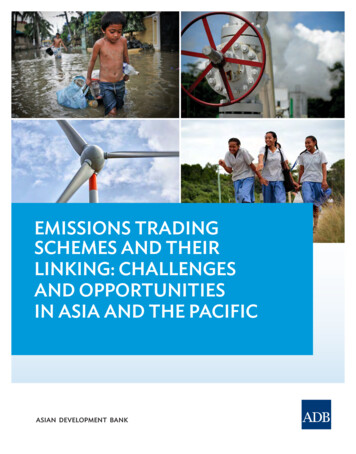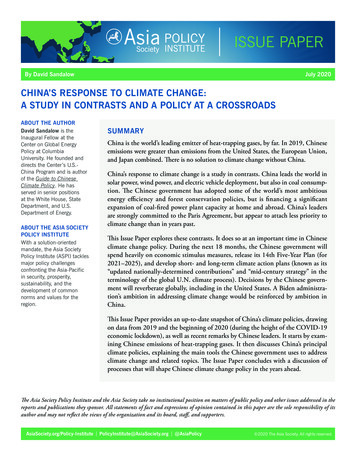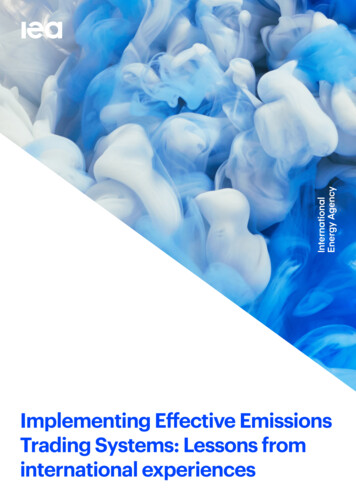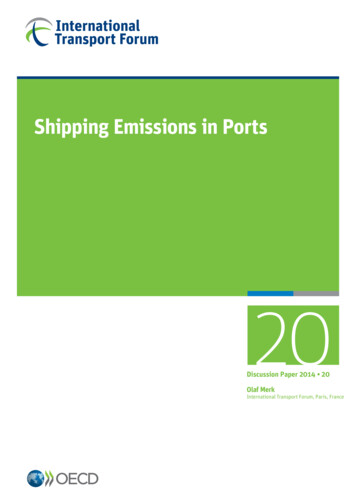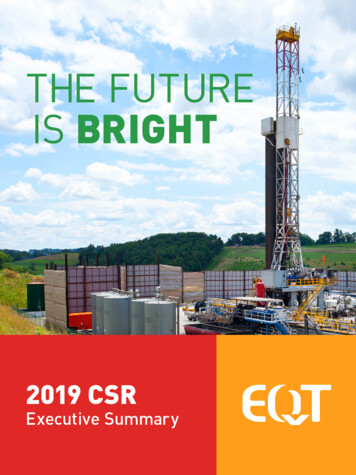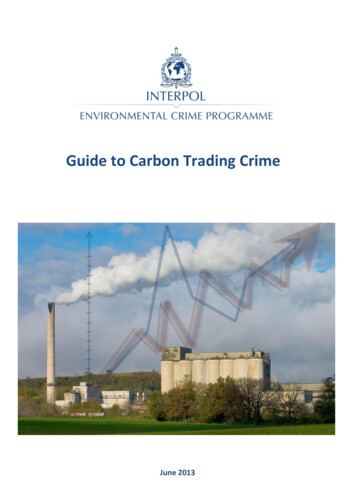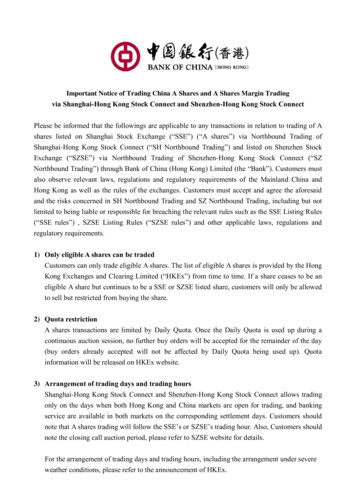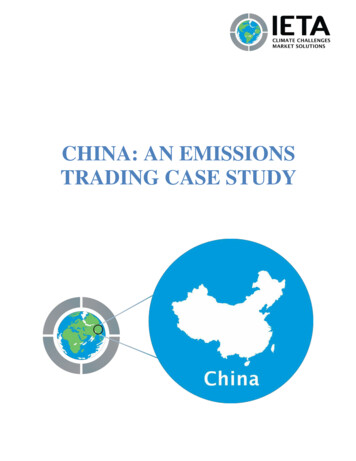
Transcription
CHINA: AN EMISSIONSTRADING CASE STUDY
China: An Emissions Trading Case StudySeptember 2016This case study incorporates all Chinese government measures over the past six years related to the development of China’semissions trading policies. The author has reviewed the most relevant government documents to inform this case study. Itis divided into two parts: a summary of the seven ETS pilots in China to date, followed by a progress report on China’snational emissions trading system (ETS) which is currently under development.TIMELINE TO A NATIONAL ETS-November 2010: The State Council announced its 12th Five-year plan (2011-15) requiring the development ofemission trading systems (ETS) in China.-October 2011: the NDRC published a Notice on carbon emissions trading pilots in which Beijing, Chongqing,Guangdong, Hubei, Shanghai, Shenzhen and Tianjin were assigned as ETS pilots.-November 2011: State Council decision to gradually promote the establishment of a carbon emissions tradingmarket.-June 2013: Shenzhen launched its ETS, the first in China.-November 2013: Shanghai and Beijing launch their ETSs.-December 2013: Guangdong and Tianjin launched their ETSs.-April 2014: Hubei launches its ETS.-June 2014: Chongqing launches its ETS.-November 2014: Joint Sino-US statement on climate change where both heads of state announced theirrespective action on climate change beyond 2020.-December 2014: The NDRC released the Provisional measures for the administration of carbon emissionrights trading (high-level regulations on the national ETS).-January 2015: The NDRC announced the launch of the national registry for voluntary emission trading.-September 2015: President Xi Jinping, on an official visit to the United States, announces on the White HouseLawn that China will launch its national ETS in 2017.-January 2016: The NDRC launches an official administrative notice to all government agencies on China with theessential steps to prepare for the national ETS.RECENT DEVELOPMENTSChina began to first progressively strengthen its commitment to climate change mitigation with the development of thecountry’s first global warming policy initiative issued by the National Development and Reform Commission (NDRC) in June,2007. The National Climate Change Program, which highlighted policy measures that can lower GHG emissions to achievea reduction target of 20% below 2005 levels by 2010 in energy consumption per unit of GDP. In November 2009, the StateCouncil announced two 2020 targets during the UNFCCC’s 15th Conference of the Parties to the Convention in Copenhagen(COP15): Reduce CO2 per unit of GDP by 40-45% relative to 2005.Increase the ratio of non-fossil energy to 15% of primary energy consumption.The following year in November, the State Council announced its 12th Five-year plan (FYP12 – from 2011 to 2015) in which,for the first time, a national carbon intensity reduction target was explicitly introduced. Chapter 21 of the FYP12 calls for the
implementation of market-based mechanisms such as emissions trading systems (ETSs) as a tool to achieve the energy andcarbon intensity goals of the Plan. In October 2011 the NDRC published a Notice that assigned the task of establishing ETSpilot programs to five cities (Beijing, Chongqing, Shanghai, Shenzhen and Tianjin) and two provinces (Guangdong andHubei). In November 2011, the State Council also released a white paper detailing China’s Policies and Actions for AddressingClimate Change which outlined their intention to: Implement low-carbon development pilots by exploring local low-carbon development modes, policies, systemsand mechanisms and speed up the establishment of industrial systems and consumption patterns and,Gradually implement a carbon emissions trading market by taking into account international experience in order to “realizethe objective of controlling greenhouse gas emissions at minimum cost”.The main objective of the establishment of pilot ETS programs was to learn lessons through experience and to facilitate thedevelopment of a national ETS which is expected to commence in 2017. The seven pilots each started their operations betweenJune 2013 and June 2014 (see section on ETS pilots). In November 2014, the United States and China released a jointstatement on climate change where both heads of state announced their respective action plans on climate change beyond2020. China’s statement involved measures including the following-which formed the foundation for China’s INDC: Peak its CO2 emissions by 2030 and try to reach this peak as early as possible; andRaise the share of non-fossil fuels in primary energy consumption to 20% by 2030;In December 2014, the NDRC released the Provisional measures for the administration of carbon emission rights tradingthat are the first legal elements of the national ETS that will be implemented from 2016. This announcement was completedin February 2015 by the NDRC’s notice covering the national market plan framework and its timeline. In March 2015, fundingfrom the World Bank’s Partnership for Market Readiness (PMR) project began, which is helping to develop the national ETS.To sum up, China now has over a decade of policy experience with carbon markets- through the CDM, the establishment ofvoluntary emissions trading, the implementation of seven ETS pilots and its preparations for a national ETS next year.
FIRST STEP: ETS PilotingNDRC guidelinesIn October 2011, the NDRC published a Notice on carbon emissions trading pilots regarding the launch of the seven pilot systems, which allstarted between June 2013 and June 2014. The seven ETS pilots cover five cities and two provinces that together represent 26.7% of China’s2014 GDP. Over 57 million tonnes of carbon have been traded under the pilots until July 31, 2015 which is valued at 308 million. Eachpilot has been designed locally by a combination of the relevant provincial and municipal Development and Reform Commission’s (DRCs),local emissions trading exchanges and thought leaders in universities and think tanks. Together these agencies worked to design andimplement the seven ETS pilots.The provinces and municipalities of these pilot programs were carefully selected. The selection of the seven pilots was based on two mainfactors: one was the willingness of provincial leaders to have an ETS pilot within their territory; the second was the need to represent avariety of Chinese economic, social, and geographic criteria. Indeed, the seven pilots cover a wide range of different economic, industrialand geographic circumstances. Together, they comprise about 25% of the country’s annual GDP, and they represent the spectrum ofeconomic development and wealth within the country.Cities included in the pilot ETS’s are under the National Central Authority and thus have the same level of independence as the provinces.The NDRC guidelines help structure the overall design of the pilot programs by requiring that each of the two provinces and five cities set: an emissions cap; an allowance allocation methodology; a monitoring, reporting and verification (MRV) system; an emissions registry, covering allowances and Chinese Certified Emission Reductions (CCERs) trades; and, an emissions trading platform (for allowances and CCERs).Common features of the seven ETSsWhilst each province and municipality government has the flexibility to design its ETS pilot’s features according to local circumstances, thereare some common features among them. These can be considered as common “basis” features: common sectoral coverage, the use of freeallowances, CCERs, and flexible provisions such as banking of allowances. Furthermore, all seven pilot ETSs cover both direct emissions fromfossil fuel use and emissions attributable to electricity use, including those from electricity generated outside their boundaries.All seven pilot systems also cover the power sector and a wide array of industries. Further details are outlined in the table below.Carbon trading and price outlook in 2014By the end of October 2014, the total trading volume of CO2 reached 13.75 million tonnes of CO2) and the turnover was more than 500 millionyuan. A total of 15.21 million quotas have been sold in 2014 at various ETS pilot auctions for a financial sum of 760 million yuan. Current pricesin China range from 1.75 to 7 per tonne, but have risen to over 15 in the Shenzhen pilot.
Summary of key policy features for each ETSBeijingChongqingReduction Goal(intensity-based)18% over 2010 levels1 7 % over 201 0levels, with a furthergoal of increasingTrading period2013 - 2015CO2 Direct (electricitygeneration and heating)and indirect(manufacturing, publicbuildings)2013 - 2015CO2 (direct andindirect), CH4, N20,GreenhouseGases CoveredThresholdCap coverageHubei19% over 2010 levels17% over 201 0 levels2013 - 2020CO2 (direct and indirect)2013 - 2015CO2 (direct andindirect)Shanghai19% over 201 0levels2013 - 2015CO2 (direct and indirect) 20,000 tonnes CO2per year from 2010 to2012 60,000 tonnes coal 20,000 tonnes CO2consumption for majorper year forsectors in 2010 or 2011. industrial sectors in2010 or 2011Above 10,000 tonnesper year for othersectors324 Mt CO2 for 201 4 About 150 Mt CO2for2013 , may bedj % tofdthe city t’s40% of the city ’s total 40% of Total Emissions 55% of the province’s total 35% of the province's 57emissions: 543covered: 242energy consumption: 21 1 total carbontotal emissions: 190companies (600 entities companies, 6 sectors: firms are listed (power,emissions. 138entities are listedare expected) from electro-plated(steel,entities are listedcement, steel, ceramics,heat supply , poweraluminum, metal alloy , petrochemical, non-ferrous, (steel, chemical, cement, petrochemical, chemical,generation, cement,calciumcarbide, plastics, paper)automobilenon-ferrous metal,petrochemical, carcaustic soda, cement,manufacturing, power power, buildingmanufacturing, andsteel & irongeneration, non-ferrous materials, textile,public buildingspaper, rubber andmetals, glass, paperchemical fiber industry)and etc.)Other sectorsTransport, Airport andbanksBaseline years2009 , 2010, 201 1ShenzhenTianjin21% over 201 0 levels19 % over 2010 levels,with a further goal ofless than 1 .69 Ton/CO22013 - 2015CO2 (direct and indirect)2013 - 2015CO2 (direct andindirect)HFCs, PFCs, SF6 5,000 tonnes CO2 per 20,000 tonnes CO2year as the average from per year from 2010 to20142009 to 2011Not releasedAllowances Issuedfor 2013-2014Guangdong388 Mt CO2/y ear for 201About 125 Mt CO2,4 (350M allowances 4.1 3% annual reduction28M reserv e)From 2008 to 201 2Transportation, textiles, andbuildings-2011 , 201 22010, 2011Airlines, ports, airports,railways, largecommercial shops, hotelsand banks2009 , 2010, 2011 3,000 tonnes CO2per year and anybuilding larger than 20,000 sqmAbout 100 Mt CO2 intotal for 201 3 - 201 538% of the city ’s totalemissions: 832 entitieslisted from 26 sectorswhich cover variousforms of industry inaddition to power, gasand water supply ;Participation open to anyfinancial institution. 197public use buildingsPublic transport2009 , 2010, 2011 20,000 tonnesCO2 per year in anyyear since 2009.Not released60% of the city ’s totalemissions: 114 entitiesIron and steel, chemicals,electricity , heat,petrochemical, oil andgas mining, civilconstruction-From 2009 to 2013
BeijingChongqingGuangdongHubeiShanghaiFree allocation based on Free allocation of 97 % in Free allocation of 92 % One-off and freegrandfathering201 3 , 97 % for industriesbefore May 30 each year. allocation for 201 3 -2015and 95% for power in 2014based on 2009 -2011Reserve: 8% of annualand 90% in 2015.considering emissionsallocation. Only 3 % ofgrowth. BenchmarkingAuctioning is used as athis reserve can beused for sectors whencomplementary methodauctioned (floor priceconditions allow.(201 4 compliance floor 20)price is 25 for the firstAuctioning is used as aAuction: a small amountauction of the y ear,complementary methodwill be auctionedclimbing to 40 for theonly to fulfill compliancefinal one)obligation (201 4 priceCarbon marketfloor: 46 )adjustment reserve: up toReserves: 1. for new5% of annual allocation.entrance 2. ForReserve is used to adjustadjustment.price between 20-150.Free allocation in 2013based on 2009 -2011Allowances Allocation emissions levels. 2014and 201 5 allowancesallocated before Mayeach year, based onverified emissions ofprevious year.Borrowing andbankingNo borrowing, banking isallowed during pilotperiod. Only spot tradingallowedNo borrowing, banking isallowed during pilotperiodNo borrowing. Banking isallowed during pilotperiodShenzhenOne-off and free allocationfor 201 3 -2015.2014 and 2015allowances to be allocatedbased on productioncapacity of the previousyear.TianjinFree allocation ofallowances each yearwith possible adjustment.Auctioning will be usedAuctioning used as acomplementary methodonly to fulfill complianceobligation (201 4 pricefloor: 35.4 )Reserve for new entrance(2 % of total allowances)and market adjustmentreserve (2 % of totalallowances)No borrowing. Banking isallowed during pilotperiodNo borrowing, banking isallowed: banked 2013 2015 quotas can be usedfor compliance until May31, 2016
BeijingOffset UsagePenalties5%, but at least 50%must be located withinthe Beijingi i litNonCompliance:Each missingallowance has to bepaid for at 3 to 5 timesthe market price of thelast six months;Chongqing8%Non-Compliance:3 x average marketprice of the last monthbeforethe compliancedeadline;Not submittingNot submitting reports:reports:rectification and up to 20-50,000. 50,000.Guangdong10%, but 70% of the totalamount must be locatedwithin GuangdongNon-Compliance:10% for new entrants*15% for pilot ETSparticipants3 x average market price(up to 50,000) andhave twice the level ofthe over emissionsdeducted for the nextyear allowances;3 x average marketprice (up to 150,000), have twice thelevel ofthe over emissionsdeducted for thenext yearallowances andadministrative penalty;Not submitting reports: 1 0- 30,000;Resisting verification: 10- 50,000;Non-publishinginformation and nonimplementing riskRegistry andExchangeBeijing EnvironmentExchangeChongqing CarbonEmission ExchangeHubeiGuangdong njin5%10%10%NonCompliance: 50-1 00,000;Non-Compliance:3 x average marketprice of last six months'Not submittingprice and deduction ofreports:the insufficient portion 1 0-30,000;from the followingResisting verification: year’s allocation; 30-50,000.Not submittingverification report: 10- 50,000 (for error orNot submitting reports:overdue) or 50-1 1 0- 30,000;00,000 (for raud: fines forfollowingyear’sinsufficient portion 3 xallocation;Hubei CarbonShanghai Environment Shenzhen EmissionEmission Exchangeand Energy ExchangeExchangeNot submitting report:loss GovernmentalFunds in 3 years.Tianjin EmissionExchange
SECOND STEP: IMPLEMENTING A NATIONAL ETSAt the end of 2014, the NDRC released a document on the Provisional measures for the administration of carbon emissionrights trading outlining basic guidelines on the framework and design of a national ETS but does not include technicalspecificities. In February 2015, the NDRC supplemented the document with a notice covering a national market planframework accompanied by a timeline for its execution. China’s FYP13 (2016-21) also includes specific references to theNational ETS Plan which is expected to launch next year.NDRC national ETS implementation roadmapThe NDRC divides the development of a national ETS in three periods: The preparation phase (2014–15): During this phase the State Council established the design andconditions of the ETS, as well as finalized the national system by:Issuing supporting details and technical standards;Determining GHG accounting methods and standards for all covered sectors;Defining the national ETS features;Completing the national registry. The operational improvement phase (2016-20): This phase is divided into two stages:First Stage (2016-17): This period will begin with a test run where all the regulations pertaining to thenational ETS will enter into force. In October 2016, the first allowances are expected to be distributed andmarket operations will commence whereby all 33 Chinese provinces and other regions will be expected toblend policies with the national system by the end of Q1 2017. -There may be up to 10,000 companies in China that will be included in the national ETS during the firststage. The actual number has not been published at the time of writing.-Second Stage (2017-20): At this stage the ETS will be fully implemented and adjusted to enhance marketstability.The stabilization and maturation phase – beyond 2020: The objective of this stage will be to increase thenumber of trading products in order to further stabilize the national ETS and to enable the enhancement of theETS’s market capacity and the exploration of linking with other existing ETS’s.The NDRC’s National ETS Guidelines: A SummaryIn 2015 the NDRC issued a notice on provisional measures for the set up of the national ETS. Those measures included: Chapter 1 on general provisions asserts that the State Council will be responsible for establishing and issuingregulations as well as enforcing compliance. Emissions trading will be established at the provincial level as well asin autonomous regions and cities. Allowance distribution and adjustments to their respective emission caps will bedetermined by the provinces and regions themselves. The scope of the national program is expected to graduallyestablish terms that will cover CO2, CH4, HFC’s, PFC’s, SF6, and NFC. There is potential for the inclusion of sectorialcoverage for CO2 produced by the power sector, metallurgy, building materials and other key industries (detailed inthe February notice).Chapter 2 covers the cap, allowance distribution and management: the State Council will set anational emissions cap which will then be broken down into a provincial cap based on historical emissions for eachof the 33 provinces and administrative regions. Allowances will be distributed using free allocation which willdecrease over time to incorporate the auctioning of allowances. The auctioning proceeds will be used to promotenational carbon emission reduction and capacity building. The State Council will determine the allowance allocationsystem based on the specific circumstances of the covered sectors, emission data and international competitivenessamong other factors. All allocation plans must be approved by the State Council
before they are sent to the provinces and regions. However provinces, autonomous regions and municipalities may implementallowance distribution methodologies featuring more stringent measure than the nationally prescribed standards Chapter 3 – Emissions trading: Allowances, early allowances and CCERs are available for entities to use ascompliance tools in the National ETS with the prospect of integrating other products over time. The State Councilwill establish “regulatory mechanisms” to maintain market stability and a national registry will maintain records ofall transactions undertaken by covered entities. NDRC will select the qualified exchanges that will serve as thenational exchanges. Chapter 4 – Monitoring, Reporting and Verification system: the State Council will be responsible forreleasing the national accounting and reporting standards for GHG emissions and for establishing verificationprocedures. The State Council will design templates for monitoring plans which Provinces and regions will be ableto adapt to meet local conditions. Covered enterprises should surrender allowances to local DRC annually as theirobligation which will be reported to the NDRC by the local DRCs. Chapter 5 – Supervision and administration: The State Council will be responsible for enforcing a‘verification mechanism’ as well as a ‘trading mechanism’ in addition to managing compliance. Nevertheless, theNDRC will be the national authority for the management of the national ETS, and the local Development and ReformCommissions (DRC) will be responsible for the surveillance of their respective ETSs and system monitoring andreporting systems. Chapter 6 – Non-compliance and legal liability: non-compliance, not-submitting reports, resistingverification or fraud will be subject to penalties. Verification firms can also be found in non-compliance if theysubmit false or misleading verification reports. Civil servants in the provinces/regions can also be subject topunishment if they abuse privileges or share emissions for example. Chapter 7 – Supplementary provisions: This section sets all the definitions and outlines for equatingemissions insofar as one tonne of GHG emissions, measured in CO2 equivalent, will be equal to one ChineseEmissions Unit or Chinese CER.The February 2015 notice also offers guidelines to improve capacity building, technical support and training. In addition, thenotice also highlights that the establishment of a national ETS has to be integrated within national or regional economic andsocial development plans. Complementary policies such as fiscal or financial supporting policies must be improved for greaterharmonization.NDRC ‘Landmark Notice’ on National ETS guidanceOn January 19 2016, the NDRC circulated a notice about China’s national ETS to all provincial DRCs, governmentadministrations, the civil aviation administration, state-owned enterprises (SOEs), and major industry associations inChina. The notice, available in Chinese here, specified that firms from 8 sectors and 15 sub-sectors which consume 10,000 tons of coal equivalent per year would be included in China’s national ETS. Those sectors include:1.2.3.4.5.6.7.8.Power (generation, heat-power cogeneration, and grid operators);Petrochemicals (crude oil refining and processing, ethylene);Chemicals (methanol, ammonia, carbide);Iron & Steel;Non-ferrous metals (copper smelting, electrolytic aluminium);Building production and materials (clinker, plate glass);Pulp & PaperAviation (civil commercial, cargo, and airports)The notice specifies that companies in each of these sectors should establish an internal ‘compliance plan’ for the nationalETS this year. Provincial and municipal DRC’s submitted to the NDRC a list of the local specific companies in each of thesesectors that meet the 10,000tce eligibility criteria by the end of February 2016. In parallel, those companies finished theirhistorical data reporting and submitted a third-party verification of their historical emissions data by the end of June 2016.
2013-2015 will be the base years for historical emissions data reporting and reporting templates were attached in the noticesent out by the NDRC. Additional templates for collecting benchmark data were also circulated.The notice also stressed that third-party verifiers should have no conflicts of interest in the national ETS. This bars thesefirms or their subsidiary companies from trading in the carbon market or performing carbon portfolio managementservices. Furthermore, verification firms will not be able to hire any staff who have worked at one of their clients during thelast 5 years. Verifiers must also hold Chinese citizenship.The notice also highlighted that the NDRC has recently launched a national MRV Q&A platform online and established aphone hotline. These services will help the NDRC’s goal of having a unified MRV system known by all ETS participants bythe end of 2016.National ETS-Timeline update and State Council guidanceAt the time of writing, the NDRC is waiting for China’s State Council (which is the penultimate policy-making body inChina’s government) to issue it with legislative guidance. This guidance will enable the NDRC to issue allowances andpenalties under the national ETS and assess how revenues from future allowance auctions will be used. The NDRC mustfirst receive legislative guidance from the State Council before it can begin fully implementing the ETS as there is not yetany specific ETS legislation in China. It is expected that the guidance will be issued to the NDRC by the end of 2016.Once the NDRC receives the State Council’s guidance, it will begin a ‘trial’ allocation process by the end of 2016 which willcarry on until 2017. The first compliance year will begin at some point in the 2017 calendar year under the first phase of thenational ETS. This phase will continue until 2019. The second phase will then commence which will expand the coverage ofthe ETS and also explore linkage with other markets. It is not yet known when allowance auctions will begin.The 7 ETS pilots will be allowed to opt-in to the national ETS starting in 2017. Shanghai, Guangdong and Beijing have allannounced that their ETS programmes will continue for another compliance year (June 30 2016-June 30 2017) before optingin to the national ETS. The remaining 4 pilots have not yet disclosed if they will continue for another year (all of the pilotshave an official timeline of 2013-2015, except for Guangdong which may continue its own ETS until 2020 subject tomodifications of its local legislation). Several of the ETS pilots have also lobbied the NDRC to bank allowances from theirETS pilots to the national ETS. The NDRC is rumoured to be exploring a discount factor for allowances banked from the ETSpilots.Defining the national emission capWhile the national ETS framework provides a glimpse into the overall potential and functionality of the system, there areseveral important elements with regards to setting a national emissions cap that have yet to be fully explored andcommunicated officially. As it does for scope, NDRC considers cap-setting an important element for an eventual nationalETS, and both an absolute cap and an intensity-based cap are under consideration. When comparing the two, NDRC states:“Each of them has its own pros and cons. But generally, the absolute cap is more favorable for controlling a system’s capwhen an economy is on a climbing trajectory, but it increases the abatement cost. The intensity target helps control the costwhen an economy is booming, and address some problems like over-allocation and price collapse when the economy iswaning. The majority of economists prefer an absolute cap. Because if the cap [were] framed in intensity terms, therewould be uncertainty in the market about the number of permits available until after the GDP data for that year had beenpublished.”
MRV system developmentOn 27 November 2014, the national carbon emissions management standardization technical committee issued a notice onthe GHG emissions accounting methods and reporting guidelines. These guidelines were submitted to public comments until20 December 2014. If approved by the State Council, the guidelines would serve as a solid foundation on which to implementa national ETS. The notice includes national standards for power generation companies, power grid companies, magnesiummanufacture, civil aviation and for several industries (steel, chemical, aluminum, glass, cement and ceramic). The guidelineswere built on the 2013 guidelines for accounting and reporting GHG emissions for ten industries.To continue the carbon emission reduction policy, in November 2014, the NDRC unveiled a draft notice for public commenton 10 national GHG emissions accounting methods and reporting guidelines.Already four GHG accounting methods and reporting guidelines have been approved: oil production, petrochemical industry,coal mining and coking industry. Eight others are in development: building, transportation, paper-making, non- ferrousmetal, food, ferrous metal, large machine manufacture and commonly-used guidelines. They all find their roots in the NDRC’sNotice on carbon emissions trading pilot (October 2011).AllocationAt the time of writing, China has not finished its allowance distribution process or methodology. It iscurrently reviewing whether or not it could stagger allocation by distributing allowances to differentindustry sectors at different times of the year. Auctioning could also take place during the first year ofcompliance with the national ETS, but it is unclear at the time of writing if the NDRC will pursue this forlimited sectors or regions. China is also considering forward trading in the national ETS, something both IETA and EUgovernments have advocated for with the NDRC in the lead up to the launch of the system.National RegistryWith regard to registries, the goal is that national and local registries ensure smooth transfers and use resources efficiently.Analyses of the relations between national and local registries shall include: (1) determining whether local registries need toestablish independent registries; (2) if local areas will require registries, clarify the positioning and functions of registries atboth national and local levels; and (3) if local registries are not needed, identify the functions of relevant local organizationsin the operation of the national registry.The design and the construction of the national registry have been already accomplished. The registry was tested and NDRClaunched the national registry for offsets (CCERs) trading in January 14th 2015. The start of the national registry is plannedto have two stages:First stage: opening the registry for CCERs users (January 2015).Second stage: improving the registry in order to establish a carbon emissions trading registry.
CARBON MARKETS WITH CHINESE CHARACTERISTICSCHALLENGES1.Manage the overlapping policies challenge – China started its policy on emission trading through a period ofexperimentation in order to learn lessons through experience and to facilitate the development of an ETS at national-. Onequestion may be how the outcomes from the seven ETS pilots would deeply determine the nature and shape of the nationalsystem and at the same time, China should make sure that its national ETS does not overlap with other policies designed toaddress climate c
China: An Emissions Trading Case Study September 2016 This case study incorporates all Chinese government measures over the past six years related to the development of China's emissions trading policies. The author has reviewed the most relevant government documents to inform this case study.

